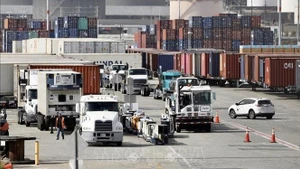The Asian Development Bank (ADB) has raised its growth forecast for the Southeast Asian region from 4.5% to 4.7%, driven by stronger manufacturing exports and public capital expenditure in major economies.
Economic growth in several ASEAN member countries, including Malaysia, Thailand, Singapore, and Vietnam, is supported by robust domestic demand, low inflation, and sustainable public investment.
In particular, Vietnam has seen an increase in foreign investment, while economies like Indonesia and the Philippines continue to meet earlier growth forecasts.
However, the Southeast Asian economy faces numerous risks, such as geopolitical tensions in various regions, trade fragmentation, and severe weather disasters adversely affecting agriculture and infrastructure.
Consequently, ADB predicts that Southeast Asian growth will stabilise at 4.7% in 2025, despite potential negative impacts from US President-elect Donald Trump's policies.
In Indonesia - the largest economy in the region - barriers are becoming more evident due to sluggish household consumption stemming from a declining middle class.
Meanwhile, Thailand is striving to recover its economy, which has been heavily impacted by the COVID-19 pandemic, particularly in tourism and services sectors. However, low domestic consumption and rising household debt may hinder this goal.
Analysts suggest that even Malaysia and Vietnam - two countries that recorded impressive economic performances in 2024 - may face challenges in maintaining growth momentum and attracting foreign direct investment (FDI) amid increasing global difficulties.
In light of the looming threat of a new trade war, analysts argue that Southeast Asian nations need to diversify their markets.
This task will not be easy as some of Europe's largest economies are grappling with political instability and economic recession, while East Asian powers like China and Japan continue to struggle with deflation.
Additionally, changes in US trade, financial, and immigration policies could dampen growth and increase inflation in developing Asian nations. ADB emphasises that these effects will become more pronounced after 2025.
A recent report from HSBC indicates that with an average annual growth rate of 4.7%, Southeast Asian countries will surpass Japan in economic size by 2029. At that time, the region will maintain its position as the fifth-largest economy globally, while India rises to fourth place and Japan drops to sixth.
HSBC notes that this growth is not driven by demographics. Instead, it is attributed to improved growth quality through innovation and advancement in global value chains.
This outcome is also reflected in the market share of high-tech manufacturing among six Southeast Asian countries - Indonesia, Malaysia, Singapore, Thailand, the Philippines, and Vietnam - alongside China’s notable production expansion.
The region's share of goods exports increased from 6.1% in 2005 to 7.4% in 2023. In addition to goods, the region also exports services in sectors such as electronics, telecommunications, and finance, with Singapore leading as a financial hub, as its total financial services export revenue reached 2.6 billion USD in 2023.
Economists assert that with such agility and flexibility, Southeast Asia enters 2025 with many opportunities for success despite facing significant challenges.
















